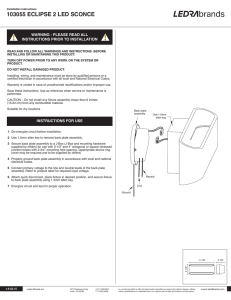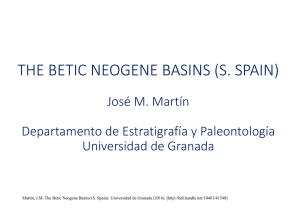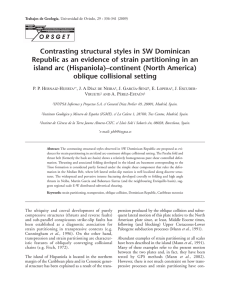On the origin of the North Pacific arcs
Anuncio
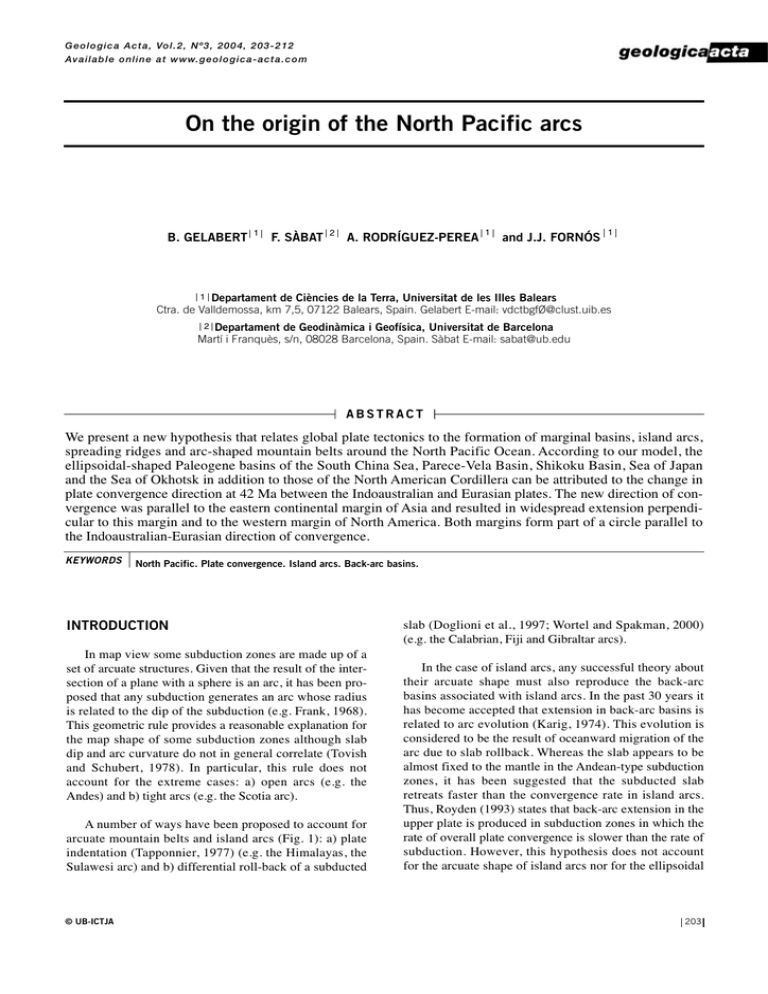
G e o l o g i c a A c t a , Vo l . 2 , N º 3 , 2 0 0 4 , 2 0 3 - 2 1 2 Av a i l a b l e o n l i n e a t w w w. g e o l o g i c a - a c t a . c o m On the origin of the North Pacific arcs B. GELABERT 1 F. SÀBAT 2 A. RODRÍGUEZ-PEREA 1 and J.J. FORNÓS 1 1 Departament de Ciències de la Terra, Universitat de les Illes Balears Ctra. de Valldemossa, km 7,5, 07122 Balears, Spain. Gelabert E-mail: vdctbgfØ@clust.uib.es 2 Departament de Geodinàmica i Geofísica, Universitat de Barcelona Martí i Franquès, s/n, 08028 Barcelona, Spain. Sàbat E-mail: [email protected] ABSTRACT We present a new hypothesis that relates global plate tectonics to the formation of marginal basins, island arcs, spreading ridges and arc-shaped mountain belts around the North Pacific Ocean. According to our model, the ellipsoidal-shaped Paleogene basins of the South China Sea, Parece-Vela Basin, Shikoku Basin, Sea of Japan and the Sea of Okhotsk in addition to those of the North American Cordillera can be attributed to the change in plate convergence direction at 42 Ma between the Indoaustralian and Eurasian plates. The new direction of convergence was parallel to the eastern continental margin of Asia and resulted in widespread extension perpendicular to this margin and to the western margin of North America. Both margins form part of a circle parallel to the Indoaustralian-Eurasian direction of convergence. KEYWORDS North Pacific. Plate convergence. Island arcs. Back-arc basins. INTRODUCTION In map view some subduction zones are made up of a set of arcuate structures. Given that the result of the intersection of a plane with a sphere is an arc, it has been proposed that any subduction generates an arc whose radius is related to the dip of the subduction (e.g. Frank, 1968). This geometric rule provides a reasonable explanation for the map shape of some subduction zones although slab dip and arc curvature do not in general correlate (Tovish and Schubert, 1978). In particular, this rule does not account for the extreme cases: a) open arcs (e.g. the Andes) and b) tight arcs (e.g. the Scotia arc). A number of ways have been proposed to account for arcuate mountain belts and island arcs (Fig. 1): a) plate indentation (Tapponnier, 1977) (e.g. the Himalayas, the Sulawesi arc) and b) differential roll-back of a subducted © UB-ICTJA slab (Doglioni et al., 1997; Wortel and Spakman, 2000) (e.g. the Calabrian, Fiji and Gibraltar arcs). In the case of island arcs, any successful theory about their arcuate shape must also reproduce the back-arc basins associated with island arcs. In the past 30 years it has become accepted that extension in back-arc basins is related to arc evolution (Karig, 1974). This evolution is considered to be the result of oceanward migration of the arc due to slab rollback. Whereas the slab appears to be almost fixed to the mantle in the Andean-type subduction zones, it has been suggested that the subducted slab retreats faster than the convergence rate in island arcs. Thus, Royden (1993) states that back-arc extension in the upper plate is produced in subduction zones in which the rate of overall plate convergence is slower than the rate of subduction. However, this hypothesis does not account for the arcuate shape of island arcs nor for the ellipsoidal 203 B. GELABERT et al. Origin of North Pacific arcs North Pacific region, the shortening was related to a plate rearrangement involving a change in the direction or in the rate of convergence. This hypothesis has a number of precursors: Wegener (1922) attributed the Pacific island arcs to shortening due to NE-SW compression along the eastern margin of Asia. Packham and Falvey (1971) noted the possible effect of the Indoaustralian plate upon the western Pacific. Yamaoka and Fukao (1987) ascribed the origin of island arcs to lithospheric buckling. ORIGIN OF ARCS AND BACK-ARC BASINS Our model of arc and back-arc basin formation (Fig. 2B-3) considers the opening, in the continental margins (passive or active), of one or several mega-tension gashes between long and narrow units bounded by steep and parallel faults which could extend down to the brittle-ductile transition (Gelabert et al., 2002). FIGURE 1 Different models of arcuate folded belt formation: 1) pla- te indentation and 2) differential roll-back of the subducting slab. shape of the back-arc basins. Doglioni et al. (1997) relates back-arc basins to the eastern rollback of slabs in W-dipping subduction zones because of the asthenosphere displacement to the east in relation to the lithosphere. However, this theory fails to distinguish between the slabs that are currently retreating and the slabs that have retreated in the past but no longer do so (i.e. the Kuriles; see below). Wortel and Spakman (2000) propose a lateral migration of the slab detachment for the origin of arcuate subductions. However, this has not been observed in many island arcs. Thus, it has not yet been fully understood why some subduction zones remain static over long periods of time, forming linear mountain chains, whereas others such as those of the Neogene western Mediterranean and western Pacific have been very mobile and have become arcuate. In short, the origin of the arcs remains to be resolved (Schubert et al., 2001) This paper seeks to address this issue by proposing a model of arc and back-arc basin formation and by applying this model to the geodynamic evolution of the North Pacific Ocean. Our hypothesis considers that arcs and back-arc basins are formed by longitudinal shortening and that in the case of the arcs and back-arc basins in the G e o l o g i c a A c t a , Vo l . 2 , N º 3 , 2 0 0 4 , 2 0 3 - 2 1 2 Faults parallel to the margin are common along both active and passive continental margins. At passive margins the main faults are extensional and parallel to the margin isolating long and narrow crustal pieces (Fig. 2A). At active margins contractional, strike-slip and even extensional faults are present and most of them are parallel to mountain belts. Specifically, steep thrust faults are encountered in the hinterland of orogenic belts. Moreover, research during the past two decades has shown that synorogenic normal faults are common in the hinterland of orogenic belts. Examples include the Quaternary normal faults in southern Tibet (Armijo et al., 1986), the High Andes (Suárez et al., 1983), Taiwan (Crespi et al., 1996) and the Miocene detachment system in the Higher Himalayas (Burchfiel and Royden, 1985). Thus, long, thin, flexible units, bounded by steep faults, exist at the continental margins or close to these margins. According to this concept of continental margin (a portion of crust with a structural lineation parallel to the continental-oceanic limit) (Fig. 2A) and depending on the direction of plate convergence, the continental margin could be the precursor of: 1) rectilinear folded belts when the plate convergence is perpendicular to the continental margin (Fig. 2B-1); 2) transcurrent shear zones when the plate convergence is oblique (Fig. 2B-2); or 3) arcs and back-arc basins when the plate convergence is parallel to the continental margin lineation (Fig. 2B-3). This paper addresses the third option. When the plate convergence produces regional shortening and when this is parallel to the continental margin (Fig. 2B-3), the fault bounded units open at right angles to the shortening vector, adopting an arcuate shape with thrusting and/or subduction in front of the bowed-out units. Consequently, one (Fig. 3A-1) or more (Fig. 3A-2) 204 B. GELABERT et al. Origin of North Pacific arcs extensional basins opens between the separating units. Initially, extension in the back-arc region is due to upper crustal collapse, which fills the void caused by arc migration. Arc migration pushes the subducting (and denser) plate horizontally, contributing to the roll-back of the subducting plate. The above mechanism is applied when horizontal stress acts on the short edges of long, thin, elastic blocks resulting in buckling of these blocks. This gives rise to a “space problem”, which must be resolved by the formation of ellipsoidal-shaped (marginal or back-arc) basins. Some kind of quantitative analysis will eventually be required to determine whether such blocks can be buckled in such a manner. We used a simple model in order to calculate the amount of basinal space created by buckling for different amounts of convergence (Fig. 4). The arc is considered to be formed by two opposite triangles, where a is the width of the back-arc basin, b is the half distance between the ends of the arc and c is the half length of the arc. The width of the back-arc basin can be regarded as a maximum value for back-arc basin extension and equals the amount of underthrusting of the adjacent lithosphere. Plate convergence is two times c minus b. Thus, for a given arc length there is a relation between the width of the basin and the plate convergence expressed as a= (c2-b2)1/2. The width of basins calculated in this way is similar to the present width of back-arc basins in the Pacific region (Table 1). This suggests that the arc evolution is accomplished with a constant arc length, which is essential for our hypothesis. It is worth noting that the analytical relation between back-arc basin width and plate convergence is not linear (Fig. 4). An incipient convergence produces a relatively large amount of extension in the back-arc region and subduction in front of the arc. As regards the timing of the basin formation, in the case of back-arc basins adjacent to continental margins (Fig. 3A), the basin growth follows the migration of the arc. Thus, the basin is younger in the area that is closer to the subduction zone. This is illustrated by the Sea of Japan, in which the Japan basin, adjacent to the continent of Asia, is older than the Yamato basin, which is closer to the Japanese subduction zone (Celaya and McCabe, 1987). FIGURE 2 Depending on the relative direction of plate convergen- ce, the continental margin may be the precursor of: 1) folded belts, when plate convergence is perpendicular to the continental margin; 2) transcurrent shear zones when convergence is oblique; or 3) island arcs and back-arc basins when convergence is parallel to the continental margin. G e o l o g i c a A c t a , Vo l . 2 , N º 3 , 2 0 0 4 , 2 0 3 - 2 1 2 Our model of arc and back-arc basin formation also accounts for island arcs located among oceanic areas. These areas also contain structural lineations and planes (e.g. transform faults). In this case, if shortening is parallel to a previous fault system, two opposite and symmetrical arcs can develop, with a new spreading axis in between the arcs (Fig. 3B-1). Examples of this type of island arc and back-arc basin are the Solomon Islands, the Parece-Vela and Shikoku basins. The structural pattern can be even more complex (Fig. 3B-2) if an intermediate 205 B. GELABERT et al. Origin of North Pacific arcs unit adopts a sigmoidal shape. Two marginal basins, each with a new spreading axis could form obliquely to the previous fault system. Two island arcs are formed in the outer part and a central sigmoidal block is present between the two marginal basins. The subduction zones dip in an inverse sense to that of the propagation of the bowed-out arcs. An example of this kind of structure is Melanesia. In back-arc basins located among oceanic areas, the younger portion of the basin is situated near the spreading axis in the middle of the basin, in contrast with the back-arc basins adjacent to continental areas. It should be pointed out that our model represents an initial stage of arc and back-arc basin formation and only applies to open arcs. With increasing plate convergence, the subducting oceanic lithosphere cannot adopt a tight arcuate shape and eventually breaks into different slabs (Fig. 3C). At the mature stage of evolution in order to produce tight arcs, further roll-back of the subducting oceanic slab could be driven by other mechanisms different from plate convergence, e.g. oceanward asthenospheric flow or gravitational body force on the slab (Charvet and Ogawa, 1994). However, we suggest that a certain contribution of plate convergence to the roll-back of the slab is possible. The asthenospheric material below the back-arc basin can be shortened by further plate convergence and expelled laterally to the oceanic “free face”, pushing out the subducting slab. The former Apennines-Maghrebides arc is an example where the Tethyan subduction broke into two slabs. The differential roll-back of these slabs gave rise to the Calabrian and Kabylean arcs and their associated back-arc basins, the Tyrrhenian Sea and the Algerian basin, respectively (Fig. 3C-1) (Gelabert et al., 2002). The North Fiji basin is a complex example of a back-arc basin formed because of the differential rollback of a single slab (Fig. 3C-2) (Schellart et al., 2002) THE WESTERN PACIFIC AND THE NORTH AMERICAN CORDILLERA: INDOAUSTRALIA VERSUS EURASIA AND NORTH AMERICA In an equatorial Mercator projection, the North Pacific Ocean seems to have two independent margins: the Asian and the North American (Fig. 5A). But if we look at the globe through a polar stereographic projection, both margins can be linked to a small circle whose pole is located at 24ºN, 9ºE (Fig. 6). This pole almost coincides with the current Indoaustralian-Eurasian convergence Euler pole (24.4ºN, 17.7ºE; DeMets et al., 1990). Moreover, this small circle is symmetrical to the NE boundary of Indoaustralian plate in the sense that it crosses this boundary through the oceanic area between the Indian and Australian continents (Fig. 5). The small circle resembles the arrow of the Java-Sumatra arc. G e o l o g i c a A c t a , Vo l . 2 , N º 3 , 2 0 0 4 , 2 0 3 - 2 1 2 FIGURE 3 Different models of island arc and back-arc basin for- mation. A) Initial stage of evolution in a continental margin. B) Initial stage of evolution in an oceanic setting. C) Developed stage with break of the subducting slab and formation of tight arcs. The boundary between the Pacific and the Eurasian plates is composed of a series of arcs and ellipsoidal basins with a roughly NNE-SSW strike formed during Oligocene-Middle Miocene times (Fig. 7): South China Sea (Taylor and Hayes, 1980), Sea of Japan (Isezaki, 1975) and Sea of Okhotsk (Burk and Gnibidinenko, 1977). During this period, a complex ellipsoidal basin also developed in the North American Cordillera, which is located close to the boundary between the Pacific and the North American plates, with a NNW-SSE main strike 206 Origin of North Pacific arcs B. GELABERT et al. Simple model to relate the width of a basin formed by buckling of the arc to different amounts of convergence. We consider the arc as almost equal to two opposite triangles. Basin width is equivalent to maximum extension and amount of induced subduction. Explanation in the text. Graph relates maximum extension in the basin to the half longitudinal convergence. FIGURE 4 (aligned with the eastern margin of the Eurasian plate, see Fig. 6). The Cordillera collapsed and spread to the west between the Middle Eocene and the Early Miocene (ca. 45-20 Ma) episode of crustal extension (Constenius, 1996) coeval with emplacement of metamorphic core complexes and regional magmatism (McQuarrie and Chase, 2000). We suggest that this Middle Eocene-Early Miocene episode of ellipsoidal-shaped basin formation was triggered 42 Ma ago by a major plate rearrangement coeval with the Indian-Eurasian collision in the Himalayas (Longley, 1997), as evidenced by the Kerguelen and EmperorHawaii hot spot traces (Fig. 5). Since this event, the fast moving Indoaustralian plate has moved NNE towards the quiescent Eurasia. Consequently, the IndoaustralianEurasian convergence direction became parallel to the eastern continental margin of Asia, producing shortening along this margin and giving rise to the island arcs and back-arc basins in this region. Our suggestion is based on the accepted assumption that aligned seamounts and oceanic islands result from hot spot traces on moving plates and can be used as kinematic indicators (Condie, 2001). Nevertheless, it has recently been proposed that TABLE 1 rectilinear oceanic features have no kinematic meaning given that they result from crackspots instead of hotspots (Hamilton, 2002, 2003) The mentioned episode of arc and back-arc basin formation began to peter out 15 Ma ago when the indentation of India into Asia led to the eastward displacement of Tibet and South China (Packham, 1996). The displacement of this continental block disturbed the kinematic connection between the Indoaustralian plate and the eastern continental margin of Asia and almost prevented another shortening along this margin; thereby reducing marginal basin activity. As regards the North America Cordillera, a number of authors (Coney and Harms, 1984; Malavieille, 1987; Wernicke, 1992) have postulated that the Early Cenozoic extensional deformation, characterized by low-angle shear zones in the core complexes, results from the postorogenic collapse of the Cordilleran crust, which had been thickened in these domains between the Mesozoic and the Paleogene compressional tectonic events. Although the crust was thick in the whole Cordilleran domain, a number of studies (Coney and Harms, 1984; Comparison between observed and calculated width of back-arc basin using model of Fig. 4. Numbers refers to km. Arc Japanese Ryukyu Kuriles Malaisian a-basin width 2b-distance extremes 2c-arc length Convergence Calculated width 700 400 500 770 2800 1200 3100 3300 3100 1500 3300 3700 300 300 200 400 665 450 565 836 G e o l o g i c a A c t a , Vo l . 2 , N º 3 , 2 0 0 4 , 2 0 3 - 2 1 2 207 B. GELABERT et al. Origin of North Pacific arcs FIGURE 5 Present-day tectonic features of SE Asia and SW Pacific. 1: Okhotsk Basin; 2: Sea of Japan; 3: Shikoku Basin; 4: Parece-Vela Basin; 5: South-China Sea; 6: Sulu Basin; 7: Celebes Basin; 8: North Fiji Basin; 9: Woodlark Basin; 10: Bismarck Sea; 11: Solomon Sea; 12: Lau Basin; 13: Mariana trough; 14: East China Sea; 15: Banda Basin; 16: West Philippine Basin; 17: Okinawa trough; 18: Aleutian Basin; 19: American Cordillera. Mercator projection shaded relief map from NOAA. B) Equatorial stereographic projection map centred at 0ºN, 160ºW. *: indicates the pole of small circles corresponding to Hawaii hot spot chain and Pacific-north Australia plate boundary; +1 and +2: indicate Euler pole of Pacific-Eurasian convergence according to Minster and Jordan (1978) and to DeMets et al. (1990), respectively. Malavieille, 1987) suggest that the thickness was maximum in the north-south striking belt located at the present position of metamorphic core complexes. This assumption seems reasonable given that the metamorphic core complexes are situated in the hinterland of the Cordilleran fold and thrust belt, where the major thrust faults are rooted. Our hypothesis involving ellipsoidalbasin formation accounts for three important phenomena: 1) the ellipsoidal shape of the extended area in the North American Cordillera during the Paleogene (McQuarrie and Chase, 2000; Suppe, 1985); 2) the presence of core complexes in the former location of maximum thickness in the hinterland where thrust faults responsible for thickening are susceptible to be bowedout; and for 3) the fact that extensional basins do not develop at all sites of maximum thickness. It may thus be suggested that the Paleogene extensional phase of the North American Cordillera is a remote effect of the Indoaustralian-Eurasian convergence on account of the extension timing, the overall ellipsoidal shape of the extended crust, the alignment of the extended area with synchronous marginal basins of the western Pacific, and the development of the extension in the hinterland of a previous orogen. G e o l o g i c a A c t a , Vo l . 2 , N º 3 , 2 0 0 4 , 2 0 3 - 2 1 2 The Middle Eocene-Early Miocene episode of extension at the Cordillera and eastern margin of Eurasia are respectively attributed to a drop in the rate of plate convergence between the Pacific and the North American plates (Constenius, 1996) and between the Pacific and the Eurasian plates (Northrup et al., 1995). These hypotheses do not account for the arcuate shape of the island arcs and mountain belts nor for the ellipsoidal shape of the extensional basins. Furthermore, extension was not restricted to basins along the east-trending strike-slip faults that bounded the escaped blocks described by Tapponnier et al. (1982); extension occurred along the western side of North America and along the eastern margin of Asia, including areas directly opposite the escaped blocks. Our model, despite being two-dimensional, accounts for 1) the arcuate geometry of the island arcs and mountain belts; 2) the ellipsoidal shape of the extensional basins; and for 3) the origin of the extension along a margin of up to more than 4000 km from the triggering plate boundary, which in this case is the convergent Indoaustralian-Eurasian boundary. Two assumptions are implicit in our hypothesis: 1) shortening is approximately parallel to the direction of 208 B. GELABERT et al. Origin of North Pacific arcs gence was transmitted through and along the continental margin of the Asian plate and even, across the EurasianNorth American plate boundary, over a considerable portion of the North American plate. These assumptions are not totally new: they are implicit in Tapponier and Molnar (1976) who related the tectonics in central Asia to the collision in the Himalayas, and in Ziegler (1978) who associated the inversion of the NW Europe basins with the collision in the Alps. It should be noted that the North American-Eurasian plate boundary is unusual given the absence of seismicity, volcanism and displacement (Grip and Gordon, 1990; Henderson, 2001). For this reason it may be suggested that stress and elastic deformation could be transmitted through this unusual boundary. AUSTRALASIA: PACIFIC VERSUS AUSTRALIA FIGURE 6 Polar stereographic projection map of the Eurasian and North American margins of the Pacific Ocean linked to a small circle. (*) indicates the pole of the small circle. (+) denotes current Indoaustralian-Eurasian convergence Euler pole according to DeMets et al., 1990. Projection map from Snyder and Voxland (1989). convergence and 2) stress and elastic deformation are transmitted a considerable distance to the plate interior. In this case, stress from the Indoaustralian-Eurasian conver- FIGURE 7 The northern boundary of the Indoaustralian plate, located in the Pacific area, and the Hawaii hot spot chain, both belong to small circles which have a common pole located at 62ºN, 70ºW (Fig. 5B). This pole is almost centred on the current Pacific-Eurasian convergence Euler pole (60.6ºN, 78.9ºW; Minster and Jordan, 1978; 61.1ºN, 85.5ºW; DeMets et al., 1990). A number of marginal, ellipsoidal-shaped basins, aligned in a WNW-ESE direction, have developed since the Late Miocene along this diffuse boundary between the Indoaustralian and Pacific plates (Fig. 7): The North Fiji Basin (Malahoff et al., Extension age of the basins cited in the text. G e o l o g i c a A c t a , Vo l . 2 , N º 3 , 2 0 0 4 , 2 0 3 - 2 1 2 209 Origin of North Pacific arcs B. GELABERT et al. FIGURE 8 Tectonic evolution of SE Asia and SW Pacific since the early Cenozoic. Explanation in the text. 1982), the Woodlark Basin (Weissel et al., 1982), the Bismarck Basin (Taylor, 1979) and the Lau Basin (Weissel and Hayes, 1977). An analysis of the relative movement of the Pacific to Eurasian plates during the last 40 Ma reveals an almost constant direction of convergence with changes in the rate of convergence (Northrup et al., 1995). On the one hand, the Pacific-Eurasian direction of convergence is parallel to the Indoaustralian-Pacific plate boundary. On the other hand, the rate of convergence was low during the Early and Middle Cenozoic, with a minimum of 30-40 mm/yr in Eocene times, but has increased to 100-110 mm/yr since the Late Miocene (10 Ma). We suggest that this high rate of convergence may have produced shortening along the Indoaustralian-Pacific plate boundary, which resulted in a widespread island arc and marginal basin formation along this boundary (Fig. 5). The special case shown in Fig. 3B-2 is in close agreement with the map structure of the Bismarck Sea, Solomon Sea, Woodlark Basin and the Papua-New Guinea area (Fig. 5). This is a complex area in which very close opposite-dipping subduction zones (of the Indoaustralian and Pacific plates) co-exist with nearby spreading ridges of the Bismarck and Woodlark basins. G e o l o g i c a A c t a , Vo l . 2 , N º 3 , 2 0 0 4 , 2 0 3 - 2 1 2 CONCLUSIONS We present a model that accounts for the formation of extensional (oceanic in general) basins in a regional tectonic setting of relative plate convergence in which (al least) three different plates are involved (Fig. 8). On the one hand, the triggering of the extension in the northwestern Pacific back-arc basins and the extension in the North American Cordillera may be attributed to a change in the direction of convergence between the Indoaustralian and Eurasian plates, which occurred 42 Ma ago. On the other hand, the triggering of the extension in the north Australian back-arc basins may be ascribed to an increase in the Pacific-Eurasian rate of convergence, which occurred 10 Ma ago. Both situations have a number of features in common (Fig. 8): a) a high rate of convergence between two of the three plates involved, and b) the direction of this convergence is parallel to the boundary between one of these converging plates and the third one. To sum up, the formation of back-arc basins along the eastern margin of Asia between the Oligocene and the Early Miocene is due to shortening of the PacificEurasian plate boundary owing to the rapid convergence between the Indoaustralian and Eurasian plates when this convergence direction is parallel to that boundary. The 210 B. GELABERT et al. formation of back-arc basins along the north Australian margin or the Indoaustralian-Pacific plate boundary may be attributed to the shortening parallel to this boundary because of the rapid convergence between the Pacific and Eurasian plates. All the data used in this work (structural maps, plate kinematics, age of basins, etc.) agree with those of Northrup et al. (1995) but our conclusions are different given the divergences in our premises and perspectives. In considering a wider region, we conclude that three plates instead of two are involved and that the longitudinal shortening plays a key role in the origin and evolution of back-arc basins and associated arcs. Our model contrasts with the paradigmatic view that considers transversal kinematics as the main factor. ACKNOWLEDGEMENTS This work was funded by the PB96-1002, PB98-0132 and BTE2000-0571 DGESIC Projects. We are grateful to Carolyn Ruppel, Robert Hatcher, Ben van der Pluijm and Dennis Brown for helpful comments, which considerably improved the manuscript. We also thank Jaume Calvet and David García-Selles for help with stereographic maps. REFERENCES Armijo, R., Tapponnier, P., Mercier, J. L., Han, T.L., 1986. Quaternary extension in southern Tibet: Field observations and tectonic implications. Journal of Geophysical Research, 91, 802-872. Burchfiel, B.C., Royden, L.H., 1985. North-south extension within the convergent Himalayan region. Geology, 13, 43-58. Burk, C.A., Gnibidinenko, H.S., 1977. The structure and age of acoustic basement in the Okhotsk Sea. In: Tolmani, M., Pitman III, W.C. (eds.). Island Arcs, Deep Sea Trenches and Back-Arc basins. Maurice Ewing Series, 1, 451-461. Celaya, M., McCabe, R., 1987. Kinematic model for the opening of the Sea of Japan and the bending of the Japanese islands. Geology, 15, 53-57. Charvet, J., Ogawa, Y., 1994. Arc-Trench Tectonics. In: P.L. Hancock (ed.). Continental Deformation. Oxford, Pergamon Press, 421pp. Condie, K.C., 2001. Mantle plumes and their record in Earth history. Cambridge, Cambridge University Press, 306 pp. Coney, P.J., Harms, T., 1984. Cordilleran metamorphic core complexes; Cenozoic extensional relics of Mesozoic compression. Geology, 12, 550-554. Constenius, K.N., 1996. Late Paleogene extensional collapse of the Cordilleran foreland fold and thrust belt. Geological Society of America Bulletin, 108, 20-39. Crespi, J., Chan, Y., Swaim, M., 1996. Synorogenic extension and exhumation of the Taiwan hinterland. Geology, 24, 247-250. DeMets, C., Gordon, R.G., Argus, D.F., Stein, S., 1990. Current G e o l o g i c a A c t a , Vo l . 2 , N º 3 , 2 0 0 4 , 2 0 3 - 2 1 2 Origin of North Pacific arcs plate motions. Geophysical Jounal International, 101, 425-478. Dewey, J.F., Cande, S., Pitman, W.C. III., 1989. Tectonic evolution on the India/Eurasia collision Zone. Eclogae Geologicae Helvetiae, 82, 717-734. Doglioni, C., Gueguen, E., Sàbat, F., Fernandez, M., 1997. The Western Mediterranean extensional basins and the Alpine orogen. Terra Nova, 9, 109-112. Frank, F.C., 1968. Curvature of island arcs. Nature, 220, 363. Gelabert, B., Sàbat, F., Rodríguez-Perea, A., 2002. A new proposal for the Late Cenozoic geodynamic evolution of the western Mediterranean. Terra Nova, 14, 93-100. Grip, A.E., Gordon, R.G., 1990. Current plate velocities relative to the hotspots incorporating the NUVEL-1 global plate motion model. Geophysical Research Letters, 17, 1109-1112. Hamilton, W.B., 2002. The closed upper-mantle circulation of plate tectonics. American Geophysical Union, Geodynamic Series, 30, 359-410. Hamilton, W.B., 2003. An alternative Earth. GSA Today 13, 11, 4-12. Henderson, D.M., 2001. New visualizations of global tectonic plate motions and plate boundary interactions. Terra Nova, 13, 70-78. Isezaki, N., 1975. Possible spreading centers in the Sea of Japan. Marine Geophysical Research, 2, 265-277. Karig, D.E., 1974. Evolution of arc systems in the western Pacific. Annual Review of Earth Planet Sciences, 2, 51-75. Longley, I.M., 1997. The tectonostratigraphic evolution of the SE Asia. In: Fraser, A.J., Matthews, S.J., Murphy, R.W. (eds.). Petroleum Geology of Southeast Asia. London, Geological Society Special Publication, 126, 311-339. Malahoff, A., Feden, R., Fleming, H., 1982. Magnetic anomalies and tectonic fabric of marginal basins north of New Zealand. Journal of Geophysical Research, 87, 4109-4125. Malavieille, J., 1987. Extensional shearing deformation and kilometer-scale “a”-type folds in a Cordilleran metamorphic core complex (Raft River Mountains, Northwestern Utah). Tectonics, 6, 423-448. McQuarrie, N., Chase, C.G., 2000. Raising the Colorado Plateau. Geology, 28, 91-94. Minster, J.B., Jordan, T.H., 1978. Present-day plate motions. Journal of Geophysical Research, 83, 5331-5354. Mrozowski, C.L., Hayes, D.E., 1979. The evolution of the Parece Vela basin, eastern Philippine Sea. Earth Planetary Science Letters, 46, 49-67. Northrup, C.J., Royden, L.H., Burchfiel, B.C., 1995. Motion of the Pacific plate relative to Eurasia and its potential relation to Cenozoic extension along the eastern margin of Eurasia. Geology, 23, 719-722. Packham, G., 1996. Cenozoic SE Asia: reconstructing its aggregation and reorganization. In: Hall, R., Blundell, D. (eds.). Tectonic Evolution of Southeast Asia. London, Geological Society Special Publication, 106, 123-152. Packham, G.H., Falvey, D.A., 1971. An hypothesis for the formation of marginal seas in the western Pacific. Tectonophysics, 11, 79-109. Royden, L.H., 1993. Evolution of retreating subduction boundaries formed during continental collision. Tectonics, 12, 629-638. 211 Origin of North Pacific arcs B. GELABERT et al. Schellart, W.P., Lister, G.S., Jessell, M.W., 2002. Analogue modelling of arc and backarc deformation in the New Hebrides arc and North Fiji Basin. Geology, 30, 311-314. Schubert, G., Turcotte, D.L., Olson, P., 2001. Mantle Convection in the Earth and Planets. Cambridge, Cambridge University Press, 940 pp. Snyder, J.P., Voxland, P.M., 1989. An album of map projections; U.S. Geological Survey, Professional paper 1453. Suárez, G., Molnar, P., Burchfiel, B.C., 1983. Seismicity, fault plate solutions, depth of faulting, and active tectonics of the Andes of Peru, Ecuador, and southern Colombia. Journal of Geophysical Research, 88, 403-428. Suppe, J., 1985. Principles of structural geology. Englewood Cliffs, New Jersey, ed. Prentice Hall, Inc., 537 pp. Tapponnier, P., 1977. Évolution tectonique du système alpin en Méditerranée: poinçonnement et écrasement rigide-plastique. Bulletin de la Société géologique de France, 7, t. XIX, nº 3, 437-460. Tapponnier, P., Molnar, P.,1976. Slip-line field theory and largescale continental tectonics. Nature, 264, 319 - 324. Tapponnier, P., Peltzer, G., Le Dain, A.Y., Armijo, R., Cobbold, P., 1982. Propagating extrusion tectonics in Asia: new insights from simple experiments with plasticine. Geology, 10, 611-616. Taylor, B., 1979. Bismarck Sea: Evolution of a back-arc basin. Geology, 7, 171-174. Taylor, B., Hayes, D.E., 1980. The tectonic evolution of the South China Sea. In: Hayes, D.E. (ed.). The tectonic and geologic evolution of Southeast Asian Seas and Islands. Washington, Geophysical Monograph Series, 23, 89-104. Tovish, A., Schubert, G., 1978. Island arc curvature, velocity of convergence and angle of dubduction. Geophysical Research Letters, 5, 329-332. Watts, A.B., Weissel, J.K., 1975. Tectonic history of the Shikoku marginal basin. Earth Planetary Science Letters, 25, 239-250. Wegener, A., 1922. Die entstehung der kontinente und ozeane. Friedrich Vieweg & Sohn Verlagsgesells-chaft mbh, Braunschweig, 135 pp. Weissel, J.K., Hayes, D.E., 1977. Evolution of the Tasman Sea reappraised. Earth Planetary Science Letters, 36, 77-84. Weissel, J.K., Taylor, B., Karner, G.D., 1982. The opening of the Woodlark basin, subduction of the Woodlark spreading system, and the evolution of northern Melanesia since midPliocene time. Tectonophysics, 87, 243-251. Wernicke, B., 1992. Cenozoic extensional tectonics of the U.S. Cordillera. In: Burchfiel, B.C., Lipman, P.W., Zoback, M.L. (eds.). The Cordilleran Orogen: Conterminous U.S. Boulder, Colorado, Geological Society of America, Geology of North America, G-3, 553-582. Wortel, M.J.R., Spakman, W., 2000. Subduction and Slab Detachment in the Mediterranean-Carpatian Region. Science, 290, 1910-1917. Yamaoka, K., Fukao, Y., 1987. Why do island arcs form cusps at their juntions?. Geology, 15, 34-36. Ziegler, P., 1978. Northwestern Europe: Tectonics and basin development. Geologie en Mijnbouw 57, 589-629. Manuscript received October 2003; revision accepted March 2004. G e o l o g i c a A c t a , Vo l . 2 , N º 3 , 2 0 0 4 , 2 0 3 - 2 1 2 212
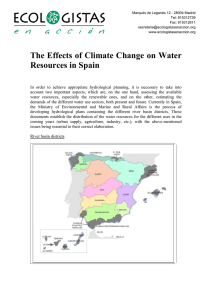
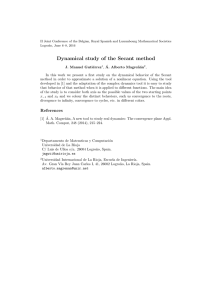
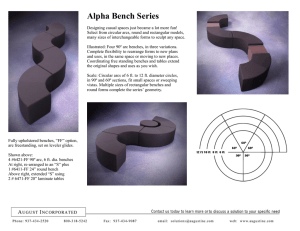
![Presentacion Chile - Canada [Modo de compatibilidad]](http://s2.studylib.es/store/data/006031439_1-d894d5d2d359230b5c2007cc916df922-300x300.png)
